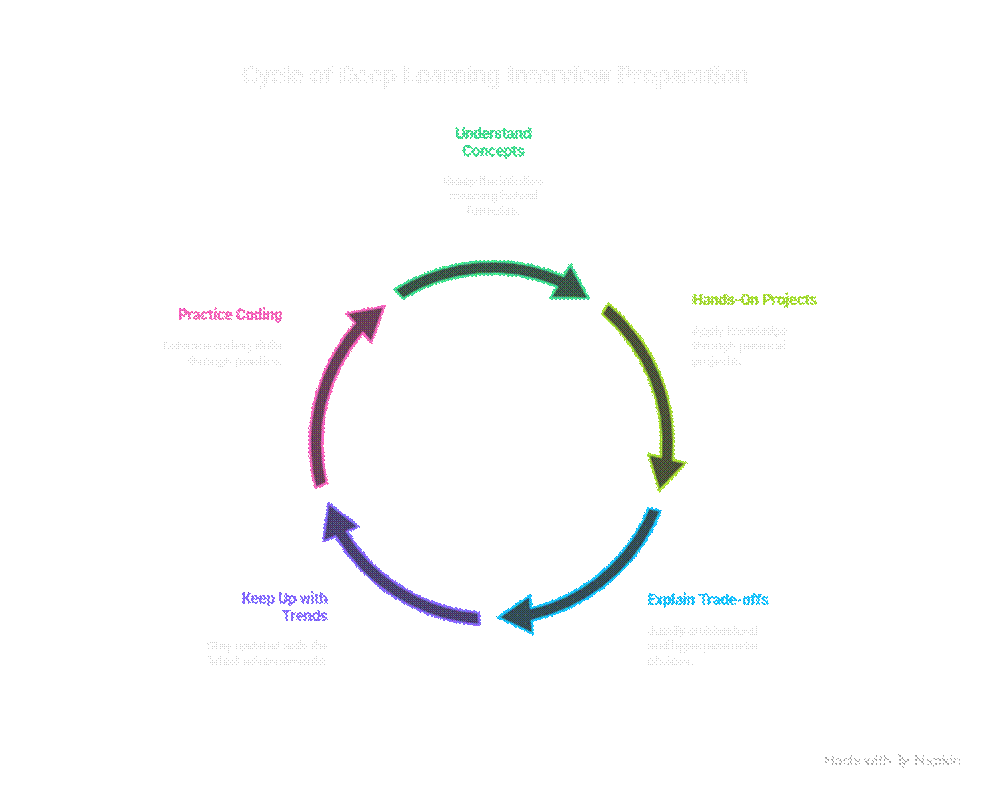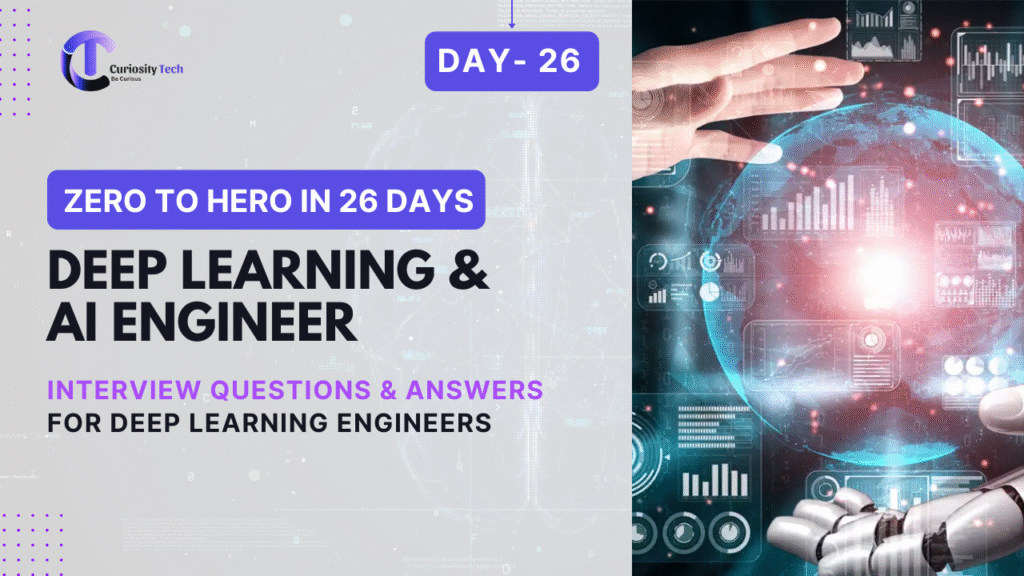6 – Interview Questions & Answers for Deep Learning Engineers
Introduction
Landing a role as a Deep Learning Engineer requires more than technical knowledge; it demands the ability to communicate complex concepts, solve real-world problems, and demonstrate hands-on expertise.
At CuriosityTech.in, learners in Nagpur are trained to tackle technical interviews, discuss architecture choices, optimize models, and present projects effectively, ensuring they are well-prepared for competitive AI roles.
1. Common Deep Learning Interview Topics
● Neural network fundamentals (MLP, CNN, RNN)
● Advanced architectures (LSTM, GAN, Transformer, ViT)
● Model optimization (regularization, dropout, batch normalization)
● Frameworks (TensorFlow, PyTorch)
● Deployment & MLOps (cloud services, edge AI, TensorFlow Serving)
● Real-world problem-solving and dataset handling
● AI ethics and bias mitigation
CuriosityTech Insight: Candidates are expected to explain concepts clearly, justify architecture choices, and demonstrate hands-on project experience.
2. Practical Q&A with Detailed Answers
Q1: Explain the difference between CNNs and RNNs.
● CNNs: Used for spatial data, primarily images; capture local patterns using convolutional layers.
● RNNs: Used for sequential data, e.g., text, speech, time series; maintain temporal dependencies via hidden states.
Example: Image classification uses CNN, whereas sentiment analysis on a sequence of text uses RNN/LSTM.
Q2: How do you prevent overfitting in deep learning models?
● Techniques:
○ Dropout layers
○ Regularization (L1/L2)
○ Data augmentation
○ Early stopping
○ Batch normalization
Practical Tip: CuriosityTech students learn to combine these techniques iteratively, observing improvements in validation accuracy and model generalization.
Q3: What is a GAN and how does it work?
● GAN (Generative Adversarial Network) consists of two networks:
○ Generator: Creates synthetic data
○ Discriminator: Distinguishes real from fake data
● Training is adversarial, improving the generator iteratively.
Example Project: Generating synthetic images for data augmentation in a computer vision pipeline.
Q4: Explain Transformers and their advantage over RNNs.
● Transformers: Use self-attention to capture dependencies across the entire sequence simultaneously.
● Advantages:
○ Parallelizable (faster training)
○ Handle long-range dependencies better than RNNs
○ Scalable for large datasets and multimodal tasks
Example: NLP tasks like translation, text summarization, and ChatGPT-like applications.
Q5: Describe a time you deployed a model in production.
● Practical Strategy:
○ Prepare a portfolio project: e.g., sentiment analysis, image classifier
○ Deploy using cloud services (AWS SageMaker, Vertex AI, Azure AI)
○ Implement monitoring for drift and performance
CuriosityTech Example: Learners deploy a CNN-based image classifier on Vertex AI, demonstrating cloud integration, scalability, and performance tracking.
3. Real-World Problem Solving Examples
- Scenario: Class imbalance in a dataset
○ Solution: Use oversampling, weighted loss functions, or data augmentation
- Scenario: Model performs poorly on unseen data
○ Solution: Hyperparameter tuning, cross-validation, or transfer learning
- Scenario: Need real-time inference on a mobile device
○ Solution: Use quantization, pruning, or TensorFlow Lite deployment
Observation: CuriosityTech emphasizes hands-on exercises that simulate interview problem-solving, giving learners confidence and practical skills.
4. Behavioral & Strategy Questions
● How do you stay updated with AI research?
○ Answer: Follow arXiv papers, AI conferences (NeurIPS, CVPR, ICML), and AI blogs like CuriosityTech.in
● Describe a challenging project and how you solved it
○ Answer: Explain the problem, approach, tools used, and impact, highlighting innovation and iterative improvement
● How do you ensure your AI models are ethical and unbiased?
○ Answer: Bias detection, diverse datasets, fairness metrics, and explainable AI frameworks
5. Example Projects to Highlight in Interviews
| Project | Skills Demonstrated | Interview Talking Points |
| Image Classification with CNN | CNN, data preprocessing, augmentation | Explain architecture, training, evaluation |
| Sentiment Analysis with LSTM | NLP, RNN, preprocessing | Discuss tokenization, embedding, and accuracy improvement |
| GAN for Data Augmentation | GAN, synthetic data generation | Show adversarial training and improvement in downstream tasks |
| Deployment on Cloud | TensorFlow Serving, Vertex AI | Highlight scalability, API integration, monitoring |
| Edge AI Deployment | TensorFlow Lite, Raspberry Pi | Demonstrate real-time inference and model optimization |
6. Tips for Excelling in Deep Learning Interviews

CuriosityTech Insight: Learners who combine deep technical knowledge with practical demonstrations consistently outperform peers in interviews.
Conclusion
Interview success for a Deep Learning Engineer in 2025 requires a mix of theoretical understanding, hands-on projects, deployment experience, and knowledge of current AI trends. At CuriosityTech.in, learners are trained with practical Q&A sessions, portfolio projects, cloud and edge deployment experience, and career strategies, ensuring they are confident, prepared, and highly employable in competitive AI roles.

